We have two restaurants with three Michelin stars in the Netherlands, the Librije and De Leest. This was our third visit and the second that I am writing about on the blog; click here to read about my previous experience in 2014. De Leest is the restaurant of chef Jacob Jan Boerma and host and sommelier Kim Veldman in the small town of Vaassen in the largest forested area that we have (the Veluwe), near Apeldoorn, and about an hour east of Amsterdam. There are 5, 6 or 7 course tasting menus. We opted for the 7-course “Micri” tasting menu (158 euros) with matching wines (67 euros).
The evening started with a set of amuse bouche. The first one was nice with water melon and a parmigiano cracker.
The second one was steak tartare with a balloon-shaped potato chip.
The lightly smoked salmon was very nice.
My favorite was the lukewarm oyster with Thai green curry. The eggplant with tomato and curry spices was also very nice. A very nice set of amuse bouche that worked well with the champagne, 9/10.
The menu started with North Sea crab with butternut squash, cream of kaffir lime leaf, lemongrass, and Buddha hand. The crab had a very nice tender texture and combined well with the different Asian fresh flavors. 9/10 The dish was paired with a Weissburgunder (Pinot Blanc) from Rheinhessen, Germany. The pairing was spectacular, as the different things on the plate all highlighted different aspects of the wine.
Unfortunately I forgot to take a photo of the second dish, which was actually the best of the evening. It was a langoustine (scampi) with Vadouvan (a mild Indian spice mix), pork belly with Tandoori, and a lightly smoked vegetable puree. This dish was so delicious that we all couldn’t help but make noises of appreciation with each bite. 10/10
It was paired with an usual wine that worked very well, a 50/50 blend of riesling and gewürztraminer from Pfalz in Germany.
The langoustine was a tough act to follow, and what followed was actually the dish we liked the least even though it was still good. Cod with citrus and yellow curry, butternut squash and parsnip. (What you see at 5 o’clock on the plate is a charred slice of parsnip, not a scallop.) The flavors worked well together and the cod had a nice tender texture. 8/10
This was paired with a falanghina from Campania, Italy. Falanghina is usually higher in acidity, which would have worked better with the dish. The pairing was OK, but not as good as the others.
Locally grown trout, cooked sous-vide at 42C/108F, with fennel, almond, beurre noisette, and vadouvan. This was a very nice dish, especially when paired with an unusual oak-aged Pinot Blanc from Alsace. 9/10
Pressé of duck foie gras with hibiscus, fresh papaya and dragon fruit. Nice flavors, although I would have preferred to be able to take slightly larger bites. 9/10 This was paired nicely with a Riesling Feinherb from Germany.
Pheasant with its own jus, truffle, roasted endives, and different textures of sunchokes. The pheasant breast was cooked perfectly (sous-vide) and the jus was very good. 10/10
The usual wine pairing is a young Cahors, a hefty Malbec from the South-West of France. Even though it was served slightly chilled and had been decanted two hours before to bring out the fruit and was therefore quite approachable, it was way too hefty a wine for the subtle flavors of the dish. When we pointed this out, we got a Spätburgunder from Pfalz instead, which worked very well. Very strange that this is not the usual pairing. Although I understand that some guests prefer to have at least one hefty red wine, that ought to mean that the chef should include a dish in the menu that can handle such a wine.
We were feeling like adding some cheese to the menu, and asked for cheeses that would pair nicely with a wine. The wine turned out to be some unusual kind of Pedro Ximenez, much lighter than the usual style and only slightly sweet, that did indeed work well with all the cheeses on the plate.
The first dessert: different structures of blueberries. Great blueberry flavor, 9/10. The same Huxelrebe Auslese, again from Germany, was served with all three desserts. This aromatic dessert wine with good acidity worked with all three, but it was best with the second dessert. (Huxelrebe is a cross between Chasselas and a rare variety of Muscat.)
The second dessert with mandarin and white chocolate was as good as the previous one, but it came out even better because the Huxelrebe worked better with this. 10/10
I don’t remember what this dessert was. Perhaps this is due to the amount of wine?
The evening ended with a great assortment of sweets that came with coffee or tea.
The dishes of Jacob Jan Boerma are very elegant with detailed fresh flavors. I thought the food was even better than during our previous visit. Contrary to last time, also the meat course was very good. 9.5/10 for the food.
Some of the wine pairings were outstanding and all of them were good.Many of his dishes have an Asian twist, and so it is no surprise that wines from Germany work best. The mistake (in my opinion) with the Cahors was quickly fixed. Very close to a perfect score for the wine as well, 9.5/10.
We enjoyed the enthusiastic stories of the sommelier about the wines. Topping up of water and wine was sometimes a bit slow, but otherwise the service was good. 8.5/10
De Leest is definitely what you can expect from a restaurant with three Michelin stars, and the wine pairings are even better than at most three star restaurants. We will be at the Librije next month, so it will be interesting to compare.

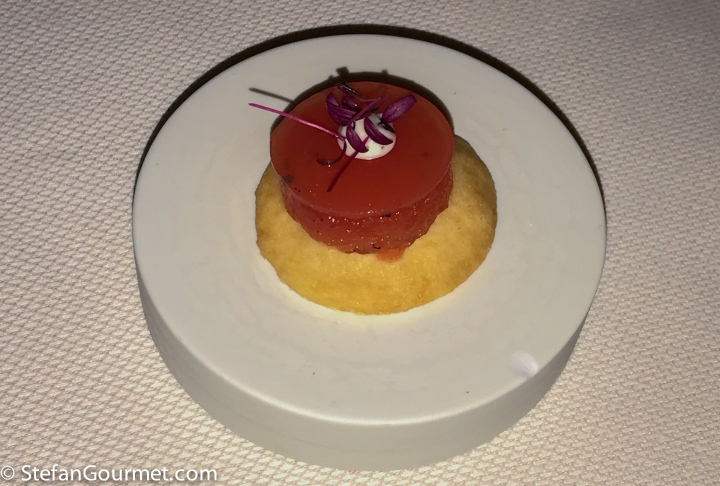
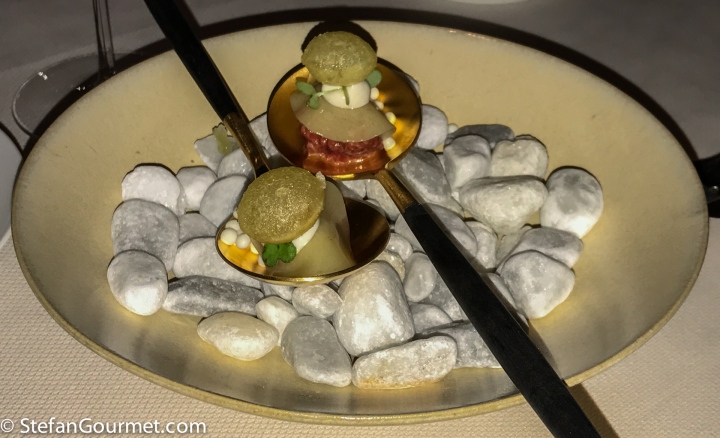

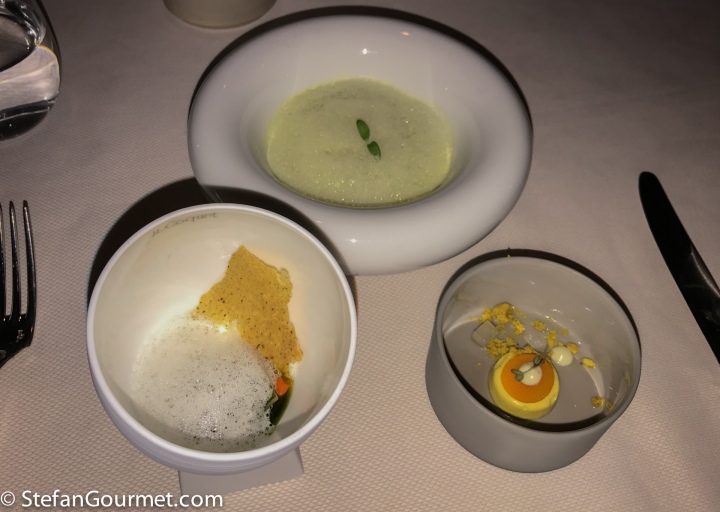
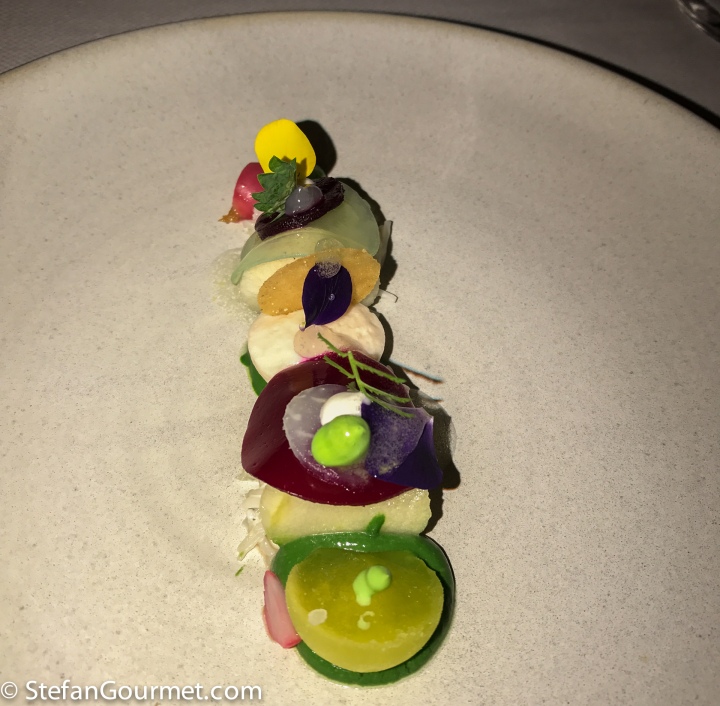





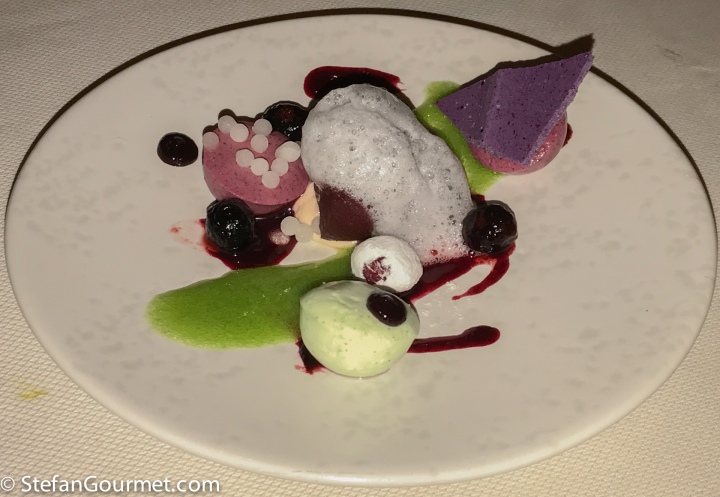




You are so lucky! I would have been extremely happy with the cheese course, and anything without foam! And the paired wines, of course. Very impressive.
LikeLiked by 1 person
I don’t care much for foam either, but in this case it didn’t bother me. We are lucky to have restaurants like that so close by.
LikeLike
Very lucky!
LikeLiked by 1 person
The wine pairings and cheese course sound outstanding!
LikeLiked by 1 person
I enjoy reading about your experiences at Michelin-starred restaurants. We certainly don’t have any close to wear I live in the boonies.
LikeLiked by 1 person
[with love from holidays!!] Teacher: why do you feel German wines best compliment somewhat Asian- oriented dishes as some of these? As you know I mostly ‘eat Asian’ but am usually not a friend of German wines many of which are simply too ‘sweet’ for my palate . . . truly would like to learn ere I try!
LikeLiked by 1 person
Many Asian (especially Thai) are aromatic and play with the balance between acidity and a touch of sweetness, just like most German wines. German wines have the reputation to be sweet, and although there are many sweet German wines, there are many great dry ones. Some bone dry, some with a touch of residual sugar that balances out the acidity. I think you will enjoy wines that are “Spätlese Trocken”. You may run into two difficulties: 1) availability of good German wines in Australia, and 2) figuring out how dry or sweet they are from the label. This post may help with that: https://stefangourmet.com/2014/04/27/german-wine/
Enjoy your holiday!
LikeLike
You have made me think! In bygone days have actually centred some stays in Rüdesheim having kind’of daylong ‘tasting’ sprees. Know all the types and enjoyed some. Methinks it has been the phenomenal growth in much more affordable Australian vintages + my love of the Loire and Bordeaux areas of France which may have given me ‘tunnel vision’. Cannot remember ‘Spätlese Trocken’ and have to find some here: somehow the first word always denotes ‘sweet/semi-sweet’ in my book, so the ‘trocken’ gets a ‘?’ behind it. Very very interesting: I can see some food and wine pairings coming up with a few local friends 🙂 !! Thanks for your time!
LikeLike
Spätlese means late harvest, and officially it means the grapes need to have a certain level of sugar. If the label just says Spätlese, the wine will be quite sweet. If it says Trocken, that means there can be a maximum of 9 grams of residual sugar per litre, provided that there is 7 grams of acid per litre as well. The wine will be very aromatic with an exiting play between the acid and the sugar, and thus perfect for sweet & sour dishes. If the dish needs more sugar for a good pairing, you could go up to Halbtrocken (max 18 grams) or Feinherb.
LikeLike
I truly bow to your knowledge! Thanks! ‘Aber als Deutsch damals eigentlich meine Heimsprache war, glaub’ ich meistens zu verstehen’ 🙂 !! Even tho’ have forgotten most except ‘food and wine’ of course!!! Truly shall try and am grateful for the unexpected ‘lecture’ so appreciated!!
LikeLiked by 1 person
Mooie recensie! Krijg erg veel zin om er in januari naar toe te gaan.
Hartelijke groet,
Robert.
LikeLiked by 1 person
En, hoe was het?
LikeLike
Het waren heerlijke lichte gerechten met prima bijpassende wijnen. De sfeer was niet helemaal ons ding, wat zakelijk en zelfs wat kil en onpersoonlijk. Maar weer een ervaring rijker 🙂 Savage in Rotterdam was voor ons onlangs een grote ontdekking. Jullie nog leuke restaurantplannen de komende tijd?
LikeLike
Ja het is inderdaad wat afstandelijk bij De Leest. Wij waren gisteravond toevallig bij Librije’s Zusje in Amsterdam. Net als de Librije in Zwolle is het daar veel gezelliger dan bij De Leest, helemaal niet afstandelijk en (omdat wij laten merken daar prijs op te stellen) zelfs joviaal. Librije’s Zusje is wat mij betreft nu net zo goed als de Librije, alleen natuurlijk wel anders, internationaler (zowel qua eten als qua gasten).
LikeLike
Librije’s Zusje is inderdaad een restaurant waar we zeker nog een keer naar toe willen gaan. Informele sfeer (houden wij ook van) en verrassende gerechten met heerlijke wijnen. Ik zal je blog zo lezen, maar zo te lezen was het weer erg goed!
LikeLiked by 1 person
Is Inter Scaldes trouwens ook wat zakelijker?
LikeLike
Ja, Inter Scaldes is ongeveer vergelijkbaar met De Leest qua formeelheid.
LikeLike